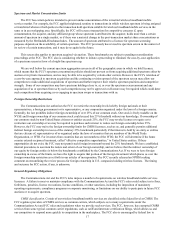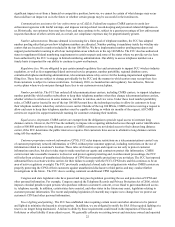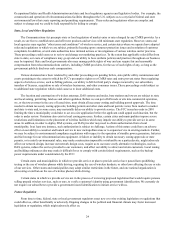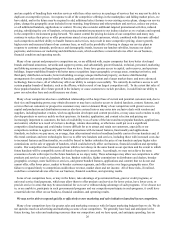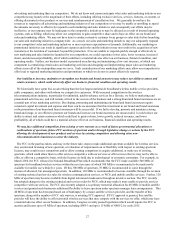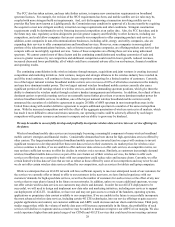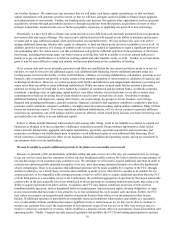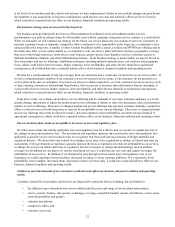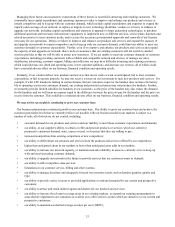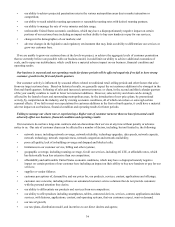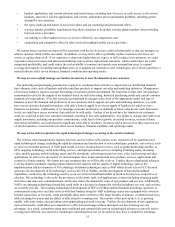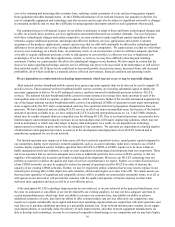Metro PCS 2011 Annual Report Download - page 38
Download and view the complete annual report
Please find page 38 of the 2011 Metro PCS annual report below. You can navigate through the pages in the report by either clicking on the pages listed below, or by using the keyword search tool below to find specific information within the annual report.27
advertising and marketing than our competitors. We do not know and cannot anticipate what sales and marketing initiatives our
competitors may launch or the magnitude of their efforts, including offering exclusive devices, services, features, or content, or
offering discounted or free products or services and reimbursement of cancellation fees. We generally do not have the
resources to respond to all advertising and marketing initiatives of our competitors or we may be unable or unwilling to spend
the amounts necessary to effectively respond to such marketing and sales initiatives and consequently our efforts may be
ineffective, or our response may be inadequate to the competitive initiatives or may be delayed as a result of internal operating
systems, such as billing, which may allow our competitors to gain competitive share and to have an effect on our brand and
sales and marketing efforts. We may not have time to conduct extensive customer focus groups or sales trials before launching
our sales and marketing initiatives companywide. As a result, our sales and marketing initiatives may not adequately respond
to our competitors' sales and marketing initiatives or meet customer expectations or demands. Additionally, our marketing or
promotional initiatives can result in significant expenses and in the end the initiatives may not result in the acquisition of new
customers or the retention of customers beyond the promotion. If we are unable to respond quickly enough or effectively to
new marketing and sales initiatives launched by our competitors, we could experience lower sales, lower revenues, increased
churn, and decreased profitability, all of which could have a material adverse effect on our business, financial condition, and
operating results. Further, our business model is premised on achieving and maintaining a low cost structure, of which one
component is centralizing certain sales and marketing activities and designing and implementing major sales and marketing
efforts across all of the metropolitan areas we serve. Such centralization of our marketing efforts may allow our competitors to
offer local or regional marketing initiatives and promotions to which we do not or cannot effectively respond.
Our inability to increase, maintain or strengthen our brands and brand awareness may reduce our ability to attract and
retain customers, which could adversely affect our business, financial condition and operating results.
We historically have spent less on advertising than the four largest nationwide broadband wireless mobile service providers,
cable companies, and others with whom we compete for customers. With increased competition in the wireless
telecommunications industry, in particular for unlimited, paid-in-advance services for a flat rate, we believe marketing and
promotional activities are, and will remain, critical to the success of the business and a strong brand and brand awareness are an
essential part of our marketing activities. Developing, promoting and maintaining our brand and brand awareness require
consistent capital investment and expense and there can be no assurance that this investment in our brand and brand awareness
or the promotion of our brand and brand awareness will be successful. If we fail to develop, promote and maintain a strong
brand and image, or our efforts to promote our brands and increase our brand awareness are unsuccessful, it could reduce our
ability to attract and retain customers which could lead to greater churn, lower growth, reduced revenues, and lower
profitability, all of which could have a material adverse effect on our business, financial condition and operating results.
We may face additional competition from existing or new entrants as a result of future governmental allocations or
reallocations of spectrum, future FCC auctions of spectrum and/or through legislative change or actions by the FCC
allowing the development of new products and services by existing competitors and allowing other non-
telecommunications businesses to enter the industry.
The FCC in the past has taken, and may in the future take, steps to make additional spectrum available for wireless services.
Any auction and licensing of new spectrum, or relaxation of requirements on or flexibility with respect to existing spectrum
licenses, may result in new competitors and/or allow existing competitors to acquire additional, or make use of existing,
spectrum, which could allow them to offer services competitive with our services or offer services that we may not be able to
offer, or offer on a competitive basis, with the licenses we hold due to technological or economic constraints. For example, in
March 2010, the FCC released its National Broadband Plan which recommends that the FCC make available 500 MHz of
spectrum for broadband wireless services within the next ten years of which 300 MHz is recommended to be made newly
available for mobile use within five years. Of this 300 MHz of spectrum, 70 MHz is recommended to come through the
auction of allocated, but unassigned spectrum. In addition, 110 MHz is recommended to become available through the revision
of existing technical and service rules for wireless communication services, or WCS, and mobile satellite services. Further, 120
MHz of spectrum may become available from digital television broadcasters through an incentive auction. The FCC recently
has adopted changes to the existing technical and services rules for WCS, which may make it more usable to provide services
competitive with our services. The FCC also recently adopted a co-primary terrestrial allocation for 40 MHz of mobile satellite
services and granted such businesses additional flexibility to lease spectrum under spectrum manager lease arrangements. This
40 MHz of spectrum has been purchased out of bankruptcy by a major satellite services provider, and the transfer of this
spectrum, along with a number of FCC rule waivers, is awaiting FCC approval. If FCC approval is granted, this satellite
provider will have the ability to offer terrestrial wireless services that may compete with the services we offer, which may have
a material adverse effect on our business. In addition, Congress recently passed legislation which would require the FCC to
auction and license up to 65 MHz of spectrum, including AWS-3 and up to 15 MHz of AWS-2, by early 2015.


